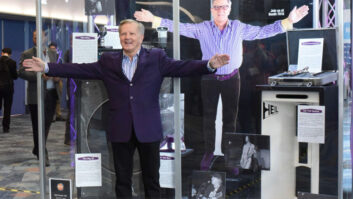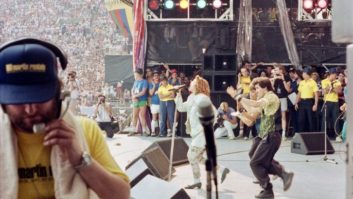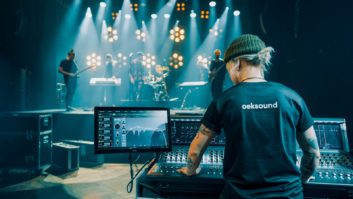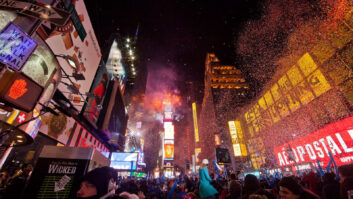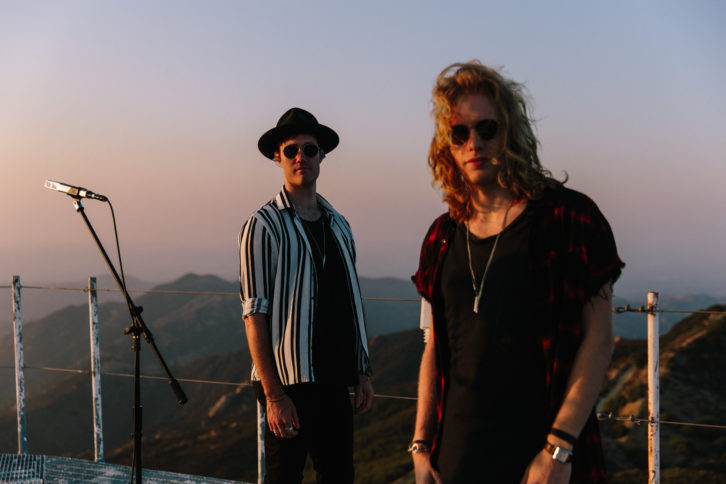
The absence of touring and the now-available time on the musicians’ hands has resulted in an outburst of creativity, bringing forth a wealth of content that would have not been attempted otherwise. Case in point, Bob Moses. Like most working artists, the duo had a full slate of dates that were wiped off the calendar. What Jimmy Vallance and Tom Howie did in response was roll the three iterations of their live show—the club set, the band set and the acoustic set, something they had never done before—into one unforgettable performance.
Climbing to the top of an abandoned radio tower in the Topanga Canyon area of their adopted town of Los Angeles, Bob Moses recorded an hourlong set in August 2020 that was streamed on Twitch in October as a performance film and released as Falling Into Focus— Live 2020, a live album and on-demand video the following month.
“It’s an old, abandoned, Cold War–era radio tower,” says Vallance, Bob Moses’ tech wizard. “There is a fallout shelter that’s supposed to withstand a nuclear attack. From this tower the West Coast could communicate to the rest of the United States. To us, during Covid, it felt like calling into the void. ‘If we do this thing, is anyone going to listen?’ It felt fitting.”
The shoot tipped the 24-hour mark, with setup beginning as early as 7a.m. Most of the time was spent hoisting the gear up (and later down) by a rope-and-pulley system with attached milk crate. One to two pieces at a time—including camera gear—were loaded into the crate. Larger items such as the kick drum were transported by tying the rope directly around them.
“We didn’t quite know what we were getting into,” says Bob Moses’ live sound engineer, Allan Bates, who is set up with his DiGiCo SD12 and SD Rack I/O, which is what he uses when he tours with the band. Bates is stationed at the bottom of the tower with 100-foot runs of cable connecting him to the somewhat-crammed band up top.
“Everyone in our band comes from either metal or punk rock backgrounds, setting up on tiny stages, throw and go,” says Vallance. “It was not the smallest thing we’ve ever played on. The good part is, it wasn’t a metal box where everything is reverbing. We had crystal-clear sound in our in-ears. We got to really lock in and make eye contact. It was a really great way to play.”
They began at the top-most level of the tower with the club set. Vallance mans Ableton Push in clip mode, an Akai APC40i, a Roland Boutique TB-03 and a Korg Minilogue; Howie is on his early ‘90s Fender Telecaster, singing into a Sennheiser MD 441 microphone. This is the same setup for the band version, for which they climbed down a rusted vertical ladder to join bass player Julio Tavarez and drummer Joe Zizzo.
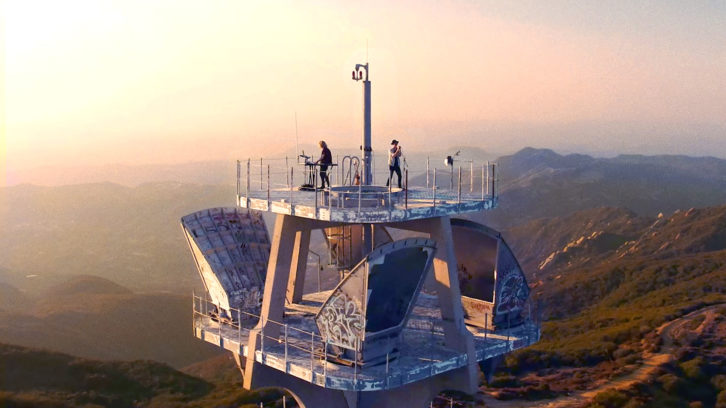
“Everything that could be DI was done like that,” says Bates. “Even for the full band set, we didn’t have amplifiers. We didn’t want to deal with getting a guitar amp up there. [Howie’s] guitar tone is mostly through his pedals anyway, and for the bass we used the Palmer Pocket Amp. Plus, the power in the building was a weird half-wired box, so we were trying to be as slim as possible.”
For the final stripped-down acoustic setup they come to ground level, with Vallance on an upright piano and Howie on an guitar (this time amped with a Fender Twin Reverb) and singing into an Electro-Voice RE20 microphone.
“When we were doing the piano, the wind was so insane,” Bates recalls. “My initial miking setup for that just didn’t work. All I could hear was the wind. I tried to go really deep using a pair of AKG C460s, then I supplemented that with the Beyer MCE 91 on the back for body. This was at four in the morning and I couldn’t tell if it was working really awesome, or if it was going to be unusable. [Vallance] likes the pianos with murky, weird tones anyway, and it ended up working out perfectly.”
The entire set was run through twice, beginning in the afternoon in order to catch the sunset and carrying on through the night into sunrise. Filmed with two cameras on tracks and four drones, the final product is visually unmatched and sonically flawless. During the daytime footage, the tower looks desolate, impossible to get to, with nothing around it for miles. At night, the city lights of Los Angeles are hazy in the distance while the lighting team strategically illuminates the tower so it looks like a majestic space station glowing from within, the band members otherworldly.
There were between 30 and 60 channels of audio over the three sets. The second performance was the one Vallance used, mixing the captured recordings wholly in Ableton. His goal was to bring out the live aspects as much as possible, turning up the drums, the bass and the vocals louder than normal, to differentiate Falling Into Focus from Bob Moses’ Days Gone By and Battle Lines albums.
“Our drummer has a Roland TM-6,” says Vallance. “On his snare drum he has a live snare, but also a trigger which then triggers the sample. I’m able to get a real snare recording and a triggered sample at the same time. Everything on his drums are triggers. A lot of people will leave the kick drum and clap drums stems in because with dance music being as tight as it is, it’s important. We let him dictate the pacing and the flow, and left his kick drums how they are, leaving that organic element in.
“There’s a lot of wind bleed, especially in the tom mikes and the overheads,” he continues. “EQing out some of the lows, cleaning it up a bit, then making sure his performance really shines and you can hear the imperfections. Dance music is always so perfect, so for us, the imperfections and the humanity coming through really makes a difference.”
Mixing the final product is a not what Vallance generally does with Bob Moses. Using the studio versions of the songs as a blueprint, and wanting to keep a non-electronic vibe to the overall sound, his approach toward Falling Into Focus was entirely different than it would be for a studio album.
“For someone who has made studio records their whole life, your brain has to work differently,” says Vallance. “You’re more forgiving because you’re looking for cohesiveness in the performance. Having one guitar the whole song so it lives in one channel, you can’t go back and take anything out. There’s a sloppiness to it that’s kind of punk rock. Trying not to overproduce was the hardest part. There’s a lot of automation and volume-riding. When I’m making a studio record, I would not usually adjust the bass to go louder by 4 dB and then back down 4 dB. It’s just a completely different way to make a record.”
Pink Floyd’s 1972 classic Live at Pompeii concert film was Bob Moses’ reference for Falling Into Focus, visually and sonically. The setting has an impact without needing to add anything to it, while the musicians’ setup with wires and cables everywhere exists within that space, showing the rawness of performance.
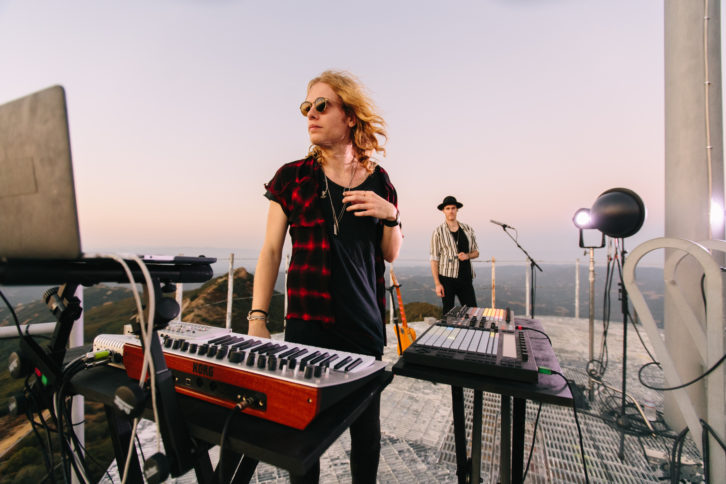
Vallance and Howie left the video editing to Jeb Hardwick to match director Owen Brown of CTRL5’s vision. Hardwick and Brown, in turn, shared their dailies via frame.io for approval.
“They were thinking about footage and we were thinking about music,” says Vallance. “For any point in the audio, you have five or six video choices from the different cameras. They would sometimes do things with footage that wouldn’t work with music, like show a sunset scene, and we’d say, ‘There’s a fill happening here so it would be great to focus on the drummer, otherwise you miss that.’ A lot of that we got from Pink Floyd—who in the ‘70s beat anything anyone has tried to do during Covid. Leave it raw, just get video of people playing music.”


